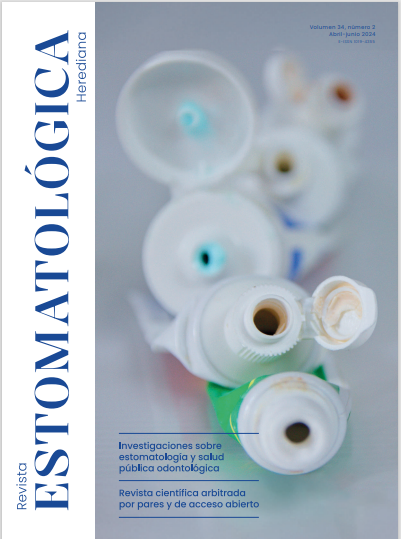Comparación de ácido hialurónico y miel de abeja en la cicatrización y en el desarrollo de bacterias en la mucosa de cobayos: estudio in vivo.
DOI:
https://doi.org/10.20453/reh.v34i2.5531Keywords:
Root canal filling, root canal filling materials, dental marginal adaptationAbstract
Objective: To compare – in vivo- the topical application of hyaluronic acid and honey in the healing and development of bacteria in the mucosa of guinea pigs. Material and methods: In vivo study conducted on a sample of 30 guinea pigs, divided into three groups, all under identical conditions (location, feeding, temperature). For five consecutive days, both in the morning and in the evening, the following treatments were topically applied: hyaluronic acid in Group A, bee honey in Group B, while no substances were applied in Group C (GC). This was carried out using a hypodermic syringe. Prior to sedation, a circular incision of 4 mm was made in the mucosa of guinea pigs in the infero-lateral left region of the incisors. Characteristics such as bleeding, edema, erythema (on days 4, 6, and 8), scar tissue, presence of suppuration (day 8), and bacterial culture (to measure colony-forming units, CFU) were identified at the wound site. Results: The group that was applied hyaluronic acid during the evolution of the wound presented a decrease in bleeding, edema and erythema, in addition, the formation of 4 mm scar tissue on the sixth day was 60.00% (n=6), there was 80.00% (n=8) epithelial union on the eighth day and demonstrated a lower amount of CFU in the analysis ranges. Conclusions: Topical application of hyaluronic acid contributes to the formation of scar tissue, wound closure, and a decrease in bacterial formation.
Downloads
References
Dahiya P, Kamal R. Hyaluronic Acid: a boon in periodontal therapy. N Am J Med Sci. 2013 May;5(5):309-15. doi: 10.4103/1947-2714.112473. PMID: 23814761; PMCID: PMC3690787.
Nikolovska R, Popovska M, Minovska A, Nikolovski B, Kapusevska B. Influence of Hyaluronic Acid in Periodontal Tissue Regeneration. Rom J Oral Rehabil. 2013;5(3):1-6.
Schencke C, Vásquez B, Sandoval C, del Sol M. El Rol de la Miel en los Procesos Morfofisiológicos de Reparación de Heridas. Int J Morphol. 2016;34(1):385-395. doi:10.4067/s0717-95022016000100056
Almasaudi S. The antibacterial activities of honey. Saudi J Biol Sci. 2021 Apr;28(4):2188-2196. doi: 10.1016/j.sjbs.2020.10.017. Epub 2020 Oct 16. PMID: 33911935; PMCID: PMC8071826.A.
Abd Jalil MA, Kasmuri AR, Hadi H. Stingless Bee Honey, the Natural Wound Healer: A Review. Skin Pharmacol Physiol. 2017;30(2):66-75. doi: 10.1159/000458416. Epub 2017 Mar 15. PMID: 28291965.
Melake N, Eissa N, Keshk T, Sleem A. Prevalence of multidrug-resistant bacteria isolated from patients with burn infection. Menoufia Med J. 2015;28(3):677-684. doi:10.4103/1110-2098.167888
Romero-Fernandez, Wilber et al. El 1, 2, 3 de la experimentación con animales de laboratorio. Rev. perú. med. exp. salud. 2016, vol.33, n.2, pp.288-299.
Calderon M, Figueroa CS, Arias JS, Sandoval AH, Torre FO. Combined therapy of Ulmo honey (Eucryphia cordifolia) and ascorbic acid to treat venous ulcers. Rev Lat Am Enfermagem. 2015;23(2):259-266. doi:10.1590/0104-1169.0020.2550
Macias O, Espinoza Pc, Suano S. Clinical application of hyaluronic acid. Revisión bibliográfica, Revista Fac. Cienc. Med. 2015 Dic;41-49
Oddent. Acído hialurónico Oddent gel gingival. https://www.hialuronico.es/oddent-hialuronico-para-odontologia. Published 2019. Accessed May 14, 2019.
Marinho A, Nunes C, Reis S. Hyaluronic Acid: A Key Ingredient in the Therapy of Inflammation. Biomolecules. 2021 Oct 15;11(10):1518. doi: 10.3390/biom11101518. PMID: 34680150; PMCID: PMC8533685.
Casale M, Moffa A, Vella P, et al. Hyaluronic acid: Perspectives in dentistry. A systematic review. Int J Immunopathol Pharmacol. 2016;29(4):572-582. doi:10.1177/0394632016652906
Neuman MG, Nanau RM, Oruña-Sanchez L, Coto G. Hyaluronic acid and wound healing. J Pharm Pharm Sci. 2015;18(1):53-60. doi: 10.18433/j3k89d. PMID: 25877441.
Pistorius A, Martin M, Willershausen B RP. La aplicación clínica del ácido hialurónico en la terapia de gingivitis. Quintessence Int. 2005;36:531-538.
Park J, Park E, Yi H. Wound Healing and Anti-inflammatory Effects of Topical Hyaluronic Acid Injection in Surgical-Site Infection Caused by Staphylococcus aureus. Int J Low Extrem Wounds. 2017;16(3):202-207. doi:10.1177/1534734617714142
Nishio E, Ribeiro JM, Oliveira AG, et al. Antibacterial synergic effect of honey from two stingless bees: Scaptotrigona bipunctata Lepeletier, 1836, and S. postica Latreille, 1807. Sci Rep. 2016;6(January 2015):1-8. doi:10.1038/srep21641
Molan P, Rhodes T. Honey: A Biologic Wound Dressing. Wounds a Compend Clin Res Pract. 2015;27(6):141-151. http://www.ncbi.nlm.nih.gov/pubmed/26061489.
Perez J. Clinical case: Application of honey for the treatment of ulcers based on scientific literature. HYGIA Enferm. 2013;83:48-50.
Downloads
Published
How to Cite
Issue
Section
License
Copyright (c) 2024 Revista Estomatológica Herediana

This work is licensed under a Creative Commons Attribution 4.0 International License.
The authors retain the copyright and cede to the journal the right of first publication, with the work registered with the Creative Commons License, which allows third parties to use what is published as long as they mention the authorship of the work, and to the first publication in this journal.























